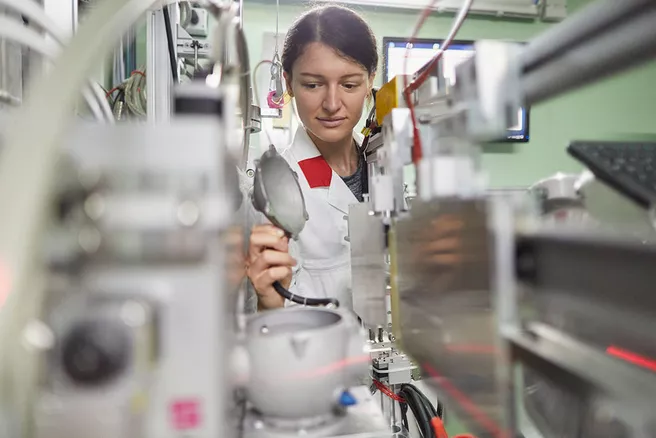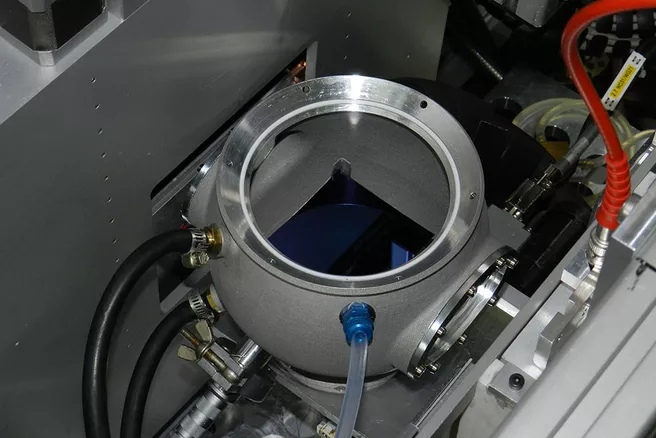On-off switches as we know them from our everyday life, the light switch for example, are not only available on a large scale, but also on a very small scale as so-called nanoswitches. For this purpose, scientists are taking advantage of the special properties of stimuli-responsive polymers. These substances change their shape depending on environmental factors such as pressure, temperature, or type of solvent. “Nanoswitches are therefore used to operate very small cantilevers, for example” explains Christina Geiger. The PhD student works at the Chair for Functional Materials at the Technical University of Munich (TUM), which is headed by Prof. Dr. Peter Müller-Buschbaum, the scientific director of FRM II.
How does a nanoswitch work?
The microscopic components are coated with the stimuli-responsive polymer. If the thin polymer layer changes its solvent content, this leads to small but measurable thickness changes in the nanometer range. These are used to deflect the cantilevers. “Switchable cantilevers are very versatile in their applications. For example, they can be used to position individual nanowires in semiconductor technology,” says Geiger, emphasizing the great benefits of extended nanoswitches.
Nanoswitch with three functions
Until now, nanoswitches have had an on and an off function, since the stimuli-responsive polymers used to take on two stable states depending on the environmental conditions. Researchers at the Technical University of Munich and the University of Potsdam have now succeeded in decisively extending these binary switches. For the first time, they have been able to demonstrate the existence of a nanoswitch that can take on three stable states with an on, an off, and a standby function. The polymer film used for this purpose is surrounded with nitrogen, pure water vapor, or a water-acetone mixture. Depending on the environment, the shape of the polymer changes to dry, swollen, or contracted. The three stable states can be clearly distinguished from each other on the basis of their different film thicknesses and can thus be assigned to the nanoswitch positions: On (dry state with nitrogen), Off (swollen state with water), and Standby (contracted state with water/acetone).
Neutrons make the switching process visible
In order to measure the exact layer thicknesses in the range of 100 nanometers and to observe the transitions from one equilibrium state to the next, the neutron reflectometer REFSANS was used at the Heinz Maier-Leibnitz Zentrum (MLZ) in Garching. What is special about this instrument is that neutrons with different wavelengths can be used simultaneously for the measurements. “With the help of this broad spectrum, we obtain many instantaneous images of the sample and can also easily follow rapid structural changes,” explains instrument scientist Dr. Jean-François Moulin from the Helmholtz Center Hereon, who performed the measurements at REFSANS.
Application in sensor technology
With their triple function, the novel nanoswitches open up interesting application possibilities, especially in the field of sensor technology. “The addition of a third switch position means that cantilevers could have a push, a pull, and a neutral position, for example,” Christina Geiger explains. Another example, she says, are flow controls at the nanoscale, where in addition to an open and a closed state, a regulated flow could also be achieved with the third stage. This would make it easier to dose substances for chemical reactions, for example.
Original publication:
C. Geiger, J. Reitenbach, C. Henschel, L. P. Kreuzer, T. Widmann, P. Wang, G. Mangiapia, J.-F. Moulin, C. M. Papadakis, A. Laschewsky, and P. Müller-Buschbaum. (2021), Ternary Nanoswitches Realized with Multiresponsive PMMA-b-PNIPMAM Films in Mixed Water/Acetone Vapor Atmospheres. Adv. Eng. Mater. 2100191. DOI: 10.1002/adem.202100191


